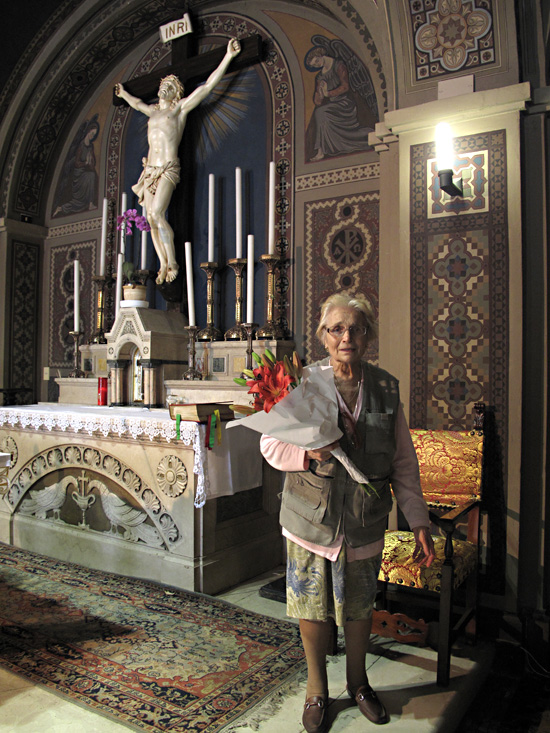
by Maureen | Jul 20, 2010 | Church, Featured Articles, Introspection, Journal, People, Photo of the Day, Photos
It would have been impossible to leave Milano without saying “goodbye” to Mary.
Our first meeting is a story in itself, finally happening last March after much anticipation. We’ve seen each other a few times since then, meeting in the little office behind the cemetery chapel.
Today I showed up in the afternoon, after the typical Italian lunch break, with red lilies in-hand for Mary. I found her at the altar, preparing everything for the next Mass. She lit up in surprise, and immediately went into the back room to split the lilies into 3 vases: 1 for either side of the altar, 1 for the Madonna.
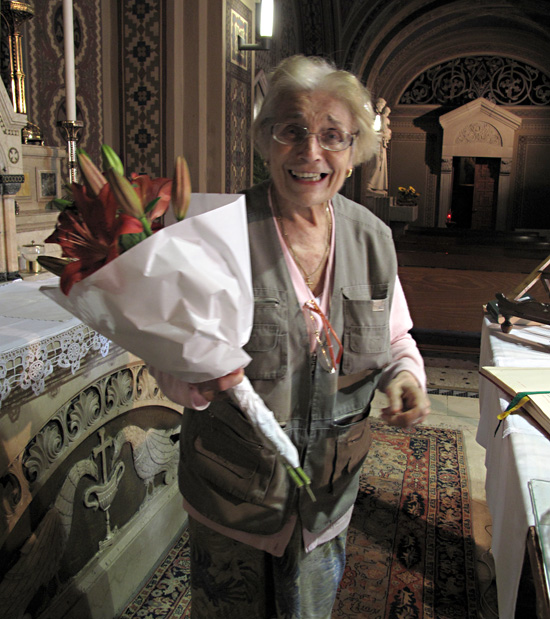
She’s the sweetest, and implored that I NOT move away from Milano. But as I’ve told her before, I have family, friends and work back in Seattle that pull me there, so I must go. Don’t think she didn’t try to convince me to stay though!

We sat at her desk and talked for a long time. We exchanged mailing addresses and I told her that, with the computer, I can call her for free. She was thrilled.
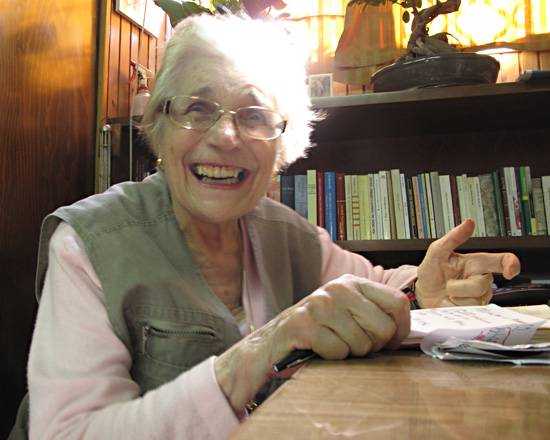
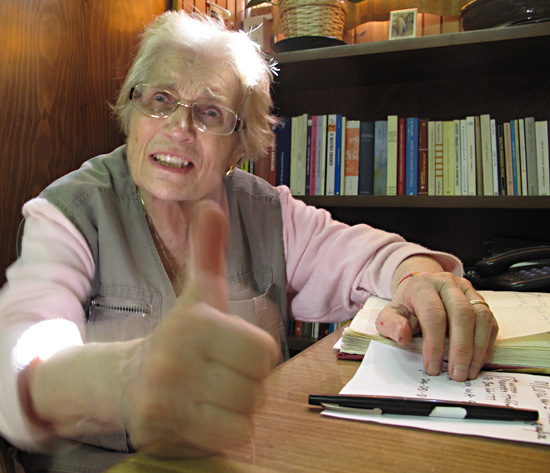
She rummaged through the cupboards, wanting to send me home with gifts. She found a bottle of Muscat sparkling wine produced by the friars, a bracelet with pictures of 12 saints, a rose-scented rosary, a little bottle of holy water and half a dozen copies of the photo of Don Giuseppe Gervasini, Milano’s very own protector. If I carry his image with me, he will protect me from all harms, she explained.
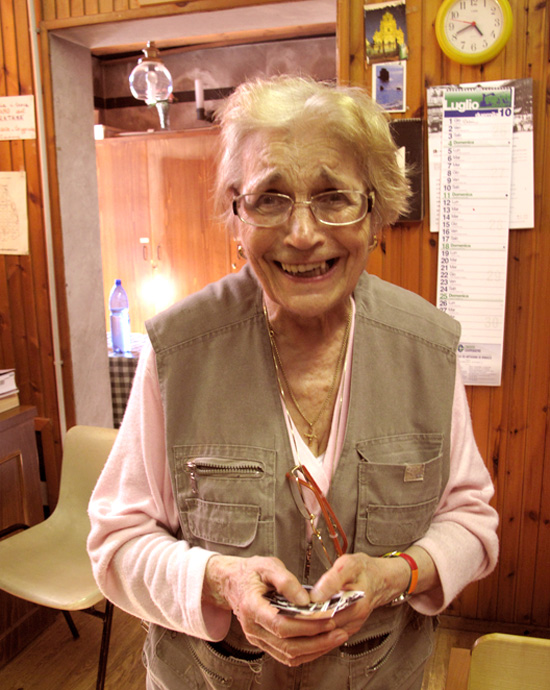
Mary also gave me a couple dozen pages on which she has written, in her “rotondo penmanship”, the names of the dead being honored at the chapel masses.
Father Francesco came into the office a few times. I had met him in my previous visits; during the last, Mary asked him to bless me for the answer to my prayers.
When we finally said our goodbye, I said “first, an Italian kiss, then an American hug”. We kissed on both cheeks, actually several times, then I gave her a big hug goodbye.
What a dear, dear lady. Meeting her has been one of the great treasures of my time here.
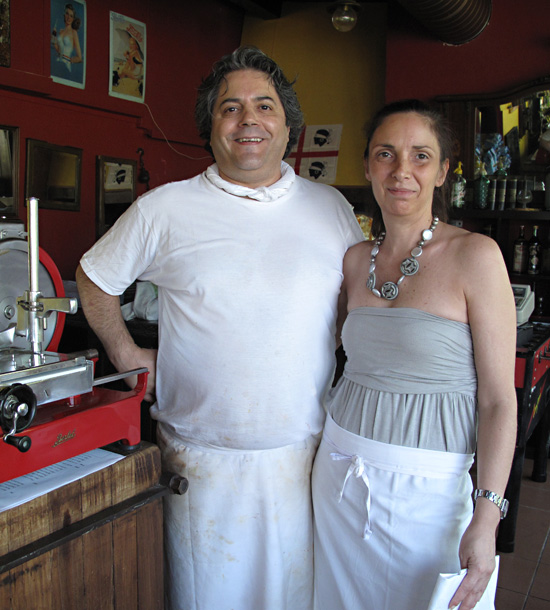
by Maureen | Jul 15, 2010 | Discoveries, Featured Articles, Food!, Journal, Meals, People, Photos
Octopus as tender as a dream, served warm and simply, with potatoes, olives and olive oil. Fish and pasta prepared and presented with an expert hand. Warm-hearted hosts, all family, welcome their guests into an easy, comfortable dining room in their restaurant alongside the Naviglio Pavese canal: Carlotta Café Bar & Restaurant. If you want to eat at all in Milano, EAT HERE.
During my year here, I have eaten at the Carlotta Café 5 times, and each time I have swooned and savored my meal. The fish could not be fresher. The light seasonings could not be more perfected. The preparation of every dish has never been pretentiously grand; it is simple, pure and complete. It’s no wonder I keep going back.
Carlotta Café owners, Ninni and Agnese, have had the restaurant for 13 years.

Siblings, Carlotta (after whom the restaurant is named) and Erik, work with their Mother in serving the café patrons. Erik is as attentive and welcoming as one could wish for when out for a nice meal.
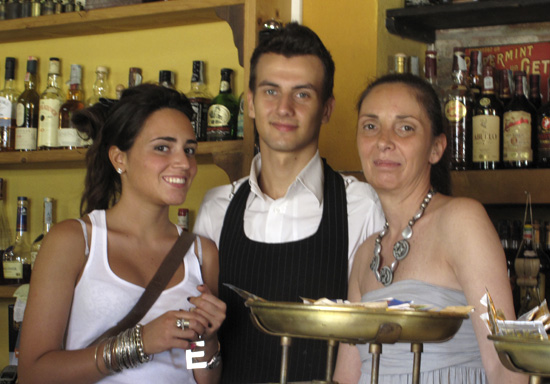
Here are a few of the dishes I’ve enjoyed in my times at the restaurant.
(The photos were taken in varying lighting conditions, evening and daytime.)
Pane Carasau, also called “Paper Music”, is a wispy-thin cracker served hot, generously drizzled with a flavorful olive oil and brightened with salt. This bread starts the meal and wakes up the mouth.
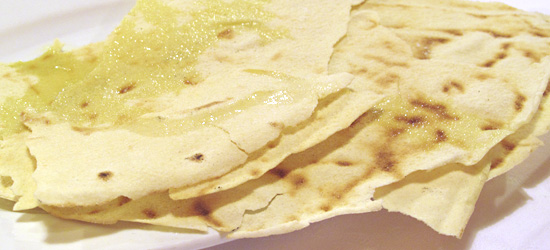
The dish that keeps bringing me back for more: Piovra con Patate – Octopus with Potatoes.
I can’t even descibe how delicious it is.
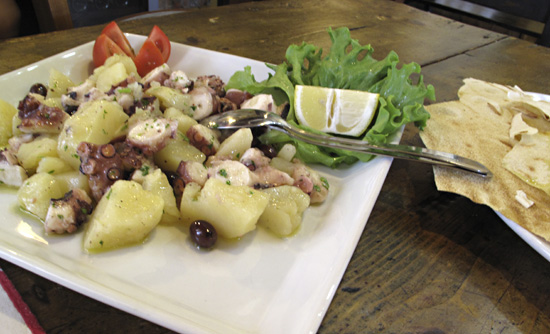
Gamberi Rossi Crudi della Mediterranea – Mediterranean Red Shrimp, served raw – are a delicacy and a gift to the palate.
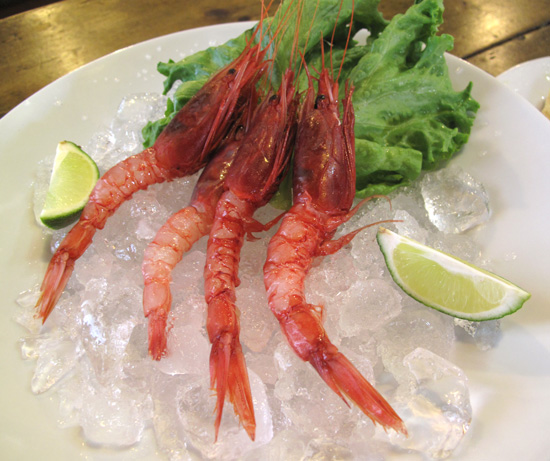
This shrimp will be splashed with lime and relished.
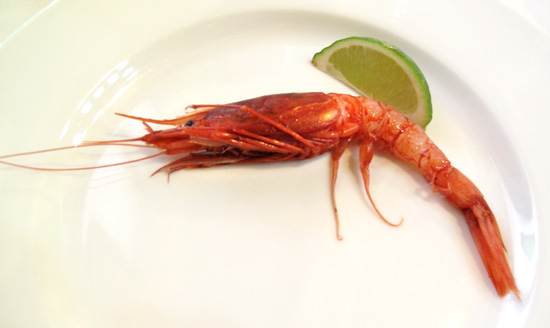
Spaghetti con Vongole e Bottarga – Spaghetti with clams and grated, dried fish roe.
Bottarga is a southern Italian gourmet specialty.
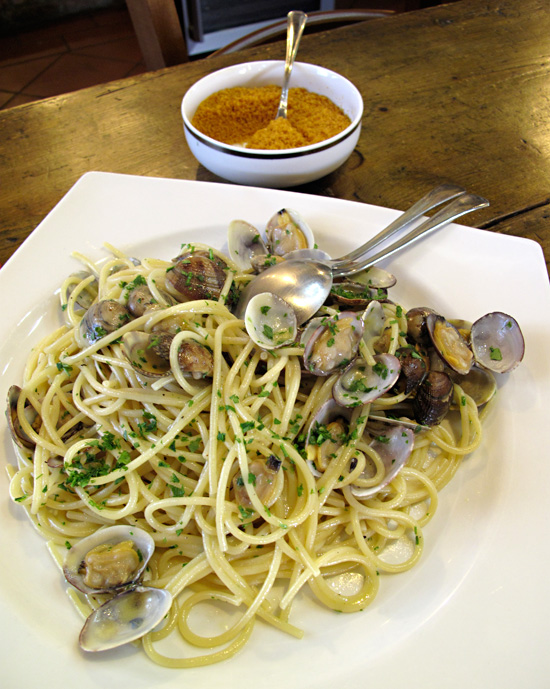
Branzino Vernaccia con Olive – Baked seabass with olives and olive oil.
Look at how beautiful those filets are. Ninni knows how to handle fish!
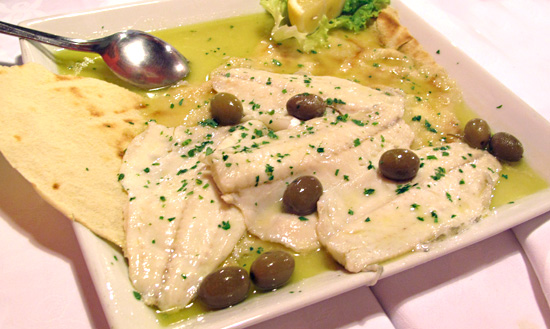
Carpaccio di Spada – Thinly sliced, raw swordfish, served with rucola – arugula – and tomato.
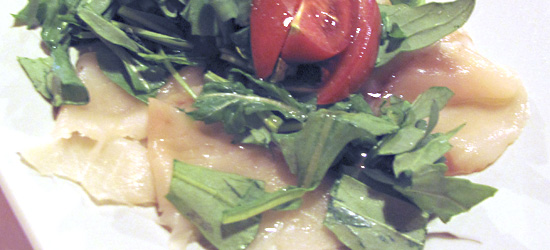
Paccheri all’Isolana – Paccheri pasta with tuna, basil and tomato.
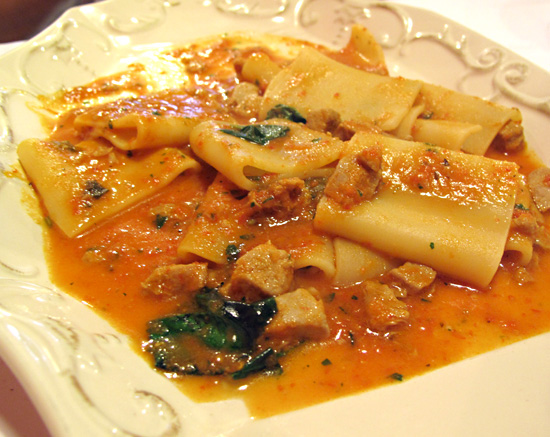
Gnocchi con Speck e Rucola – Potato Gnocchi with lightly smoked speck (cured meat somewhat similar to prosciutto), arugula and a creamy sauce.
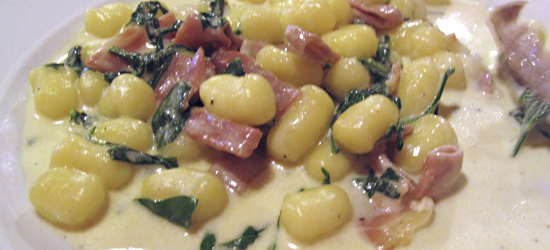
The Carlotta Café offers a full bar, wine list and caffé. Order an ice-cold bottle of Mirto, a Sardegnan specialty from myrtle leaves and berries, as a digestif to sip after your meal.
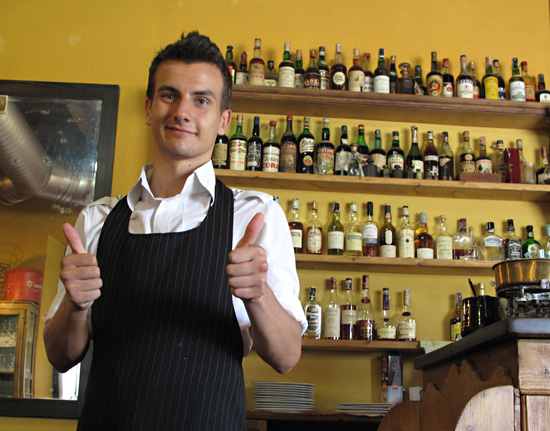
The Red Room is the quiet, more intimate room set off from the bar and main dining area.
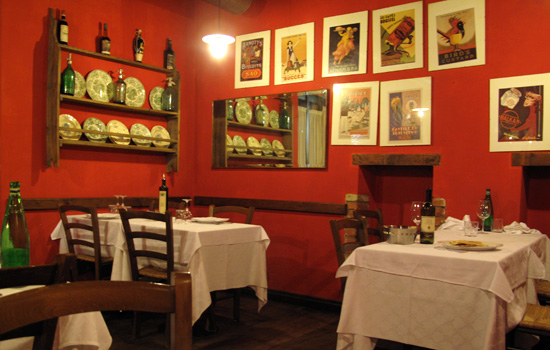
There’s also a north-facing Terrazo Room with it’s pleasant light.
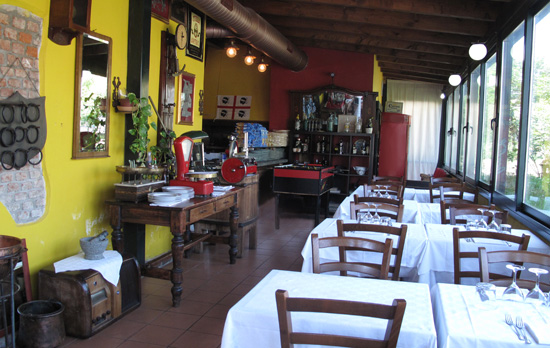
The café is not in the central hub-bub of town, and unlikely to be found by tourists. It’s not close to a subway stop and, for me without a car or scooter, it would be a long walk on a hot day. So I gladly take a quick cab ride to the restaurant and it is oh-so worth it.
Ninni and Agnese offer a “Cena a Base di Pesce“, dinner based on fish, at an incredibly reasonable price. Make it simple for yourself: order this special dinner and a nice bottle of wine then sit back and enjoy the steady stream of expertly prepared foods that arrive at your table. You will go home happily satisfied. And you, too, will dream about the octopus. (Tell them “Maureen” sent you.)
(Check with them on their current pricing, since it may change.)
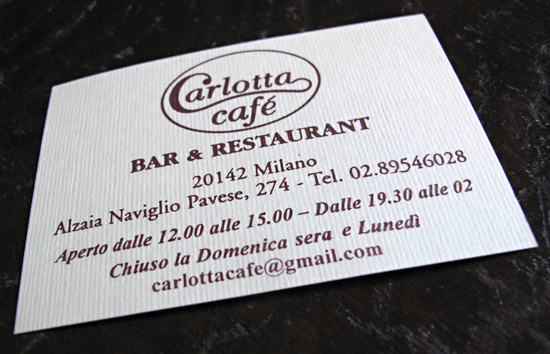
Carlotta Café Bar & Restaurant
Alzaia Naviglio Pavese, 274
20142 Milano, Italia
TEL: 02.89546028
E-MAIL: carlottacafe@gmail.com
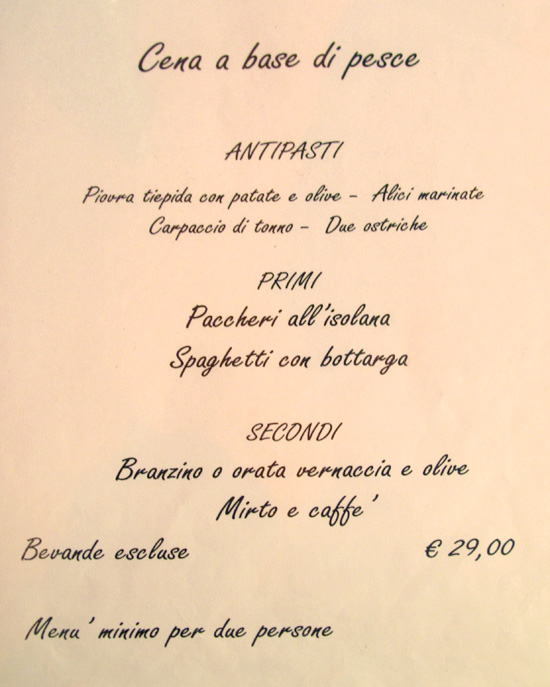
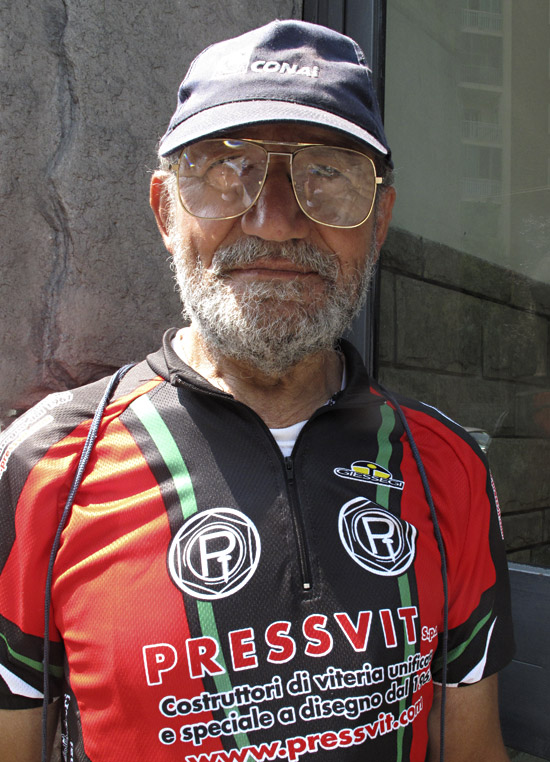
by Maureen | Jul 14, 2010 | Featured Articles, Journal, People, Photo of the Day, Photos
My “History Buff on Wheels“, Angelo, went rolling past me along the canal this morning. In a cycling daze and not recognizing him, I nodded and said the usual “ciao” as one cyclist to another. Mere moments later, he pulled up on my left, took my pace, greeted me and commented that it had been a long time since we had seen each other.
“Angelo! Ciao!”
What a great surprise to see him.
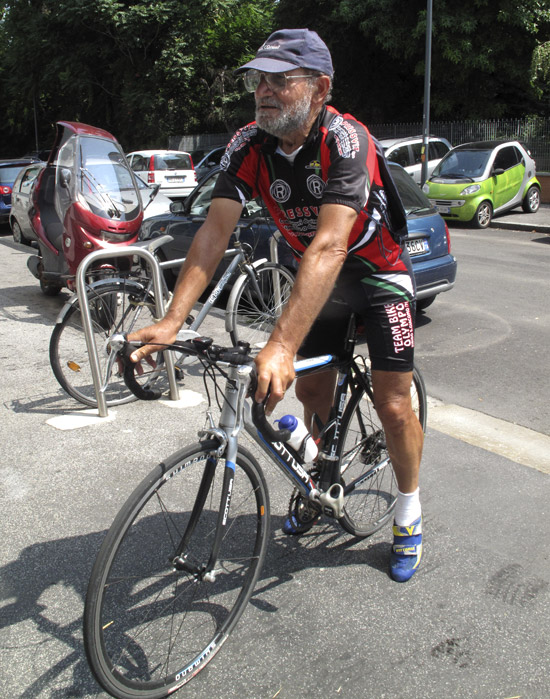
It had been January 11th, a very cold day, when we had ended up riding for 3 hours together, and all that time he had given me an historic commentary on Italy, Europe, the wars and politicians. It was Angelo that showed me the little back roads through the farmland that I have come to cherish so much. It was Angelo that first took me to Cascina Femegro, where I now go for the fresh ricotta cheese I savor.
Today, we rode for a half an hour together, all the way back to my place. We stood out on the walk under the scorching sun, talking about more history and geography, language and dialects. What a pleasure. We said a warm goodbye, but hoped to see each other another day on the bike path before I go.
“Ciao, Angelo!”

by Maureen | Jul 11, 2010 | Introspection, Journal, Quips
This is not a scholarly blog with a foundation in formal Art or European History. I’m the first to admit my ignorance in those realms. And on the web, one can find formal information and imagery on just about any topic. I have no desire to regurgitate what’s readily available out there, although I do provide links now and then to informative sites.
Rather, this is a collection of sometimes-knee-jerk, sometimes-thoughtful observations and responses to having plopped myself down in Milano for a year. I write about the jaw-droppingly beautiful, the quirky and questionable, the forefront, the frustrating and the fulfilling.
Living here is “the stuff of dreams”, but it is not “glamorous” as so many seem to believe. It is daily life in a place where they speak a different language and do things differently, all against a backdrop that sometimes takes my breath away from either beauty or cigarette smoke.
I write about ants in my kitchen and hardwater in my pipes. About an old lady in her pajamas on New Year’s Day, and an old man gathering fire wood along the canal. There’ve been stories about feeding fresh ricotta cheese to farm cats, buying old linens at the flea market, and eating pureéd rabbit livers and raw meat.
This blog is simply about what catches my eye, my mind and my heart. It is increasingly populated with stories of the people that have stepped into my days. I’ve filled my mind with enough imagery to inspire me for a lifetime.
This is no movie set. The Lombardia sun is usually obscured by haze. The winter was interminably gray. There is “dog do” on the sidewalks and no one else to handle the details for me. But the struggles have been authentic. The food is remarkably unlike an Italian restaurant menu in the U.S. The people have been slowly responsive. And I’ve started to “talk with my hands”, especially when in an animated conversation in Italian with a friend.
Having been here now for over a year, and facing an imminent departure and return to The States, I feel mixed and wistful… and deeply full.
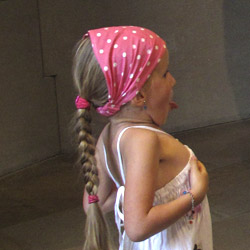
by Maureen | Jul 11, 2010 | Discoveries, Featured Articles, Journal, People, Photo of the Day, Photos, Quips
The little girl was unrestrained and so pleased with herself. She and I both saw the humor of her Minnie Mouse joining Michelangelo’s unfinished Rondanini Pietá. As I think about it further, I wonder which creator, Michelangelo or Disney, has had greater cultural influence? (Many would be aghast at my putting those two in the same sentence, but it’s a legitimate question.)
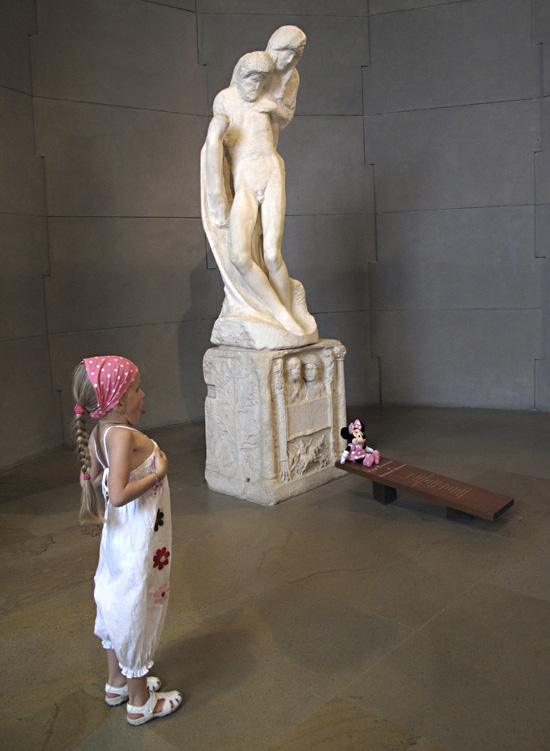
Though I’ve been in and around the Castello Sforzesco, one of the jewels of Milano, a number of times while here, I had not gone in to view the art and history exhibitions there. Before my departure, I wanted to “at least” see the Rondanini. Michelangelo had worked on this Pietá for many years and, they say, even up to a few days before his death in 1564. Here’s a video about the restoration done on the Rondanini Pietá (in Italian, but visually interesting, nonetheless, for those that don’t understand it).
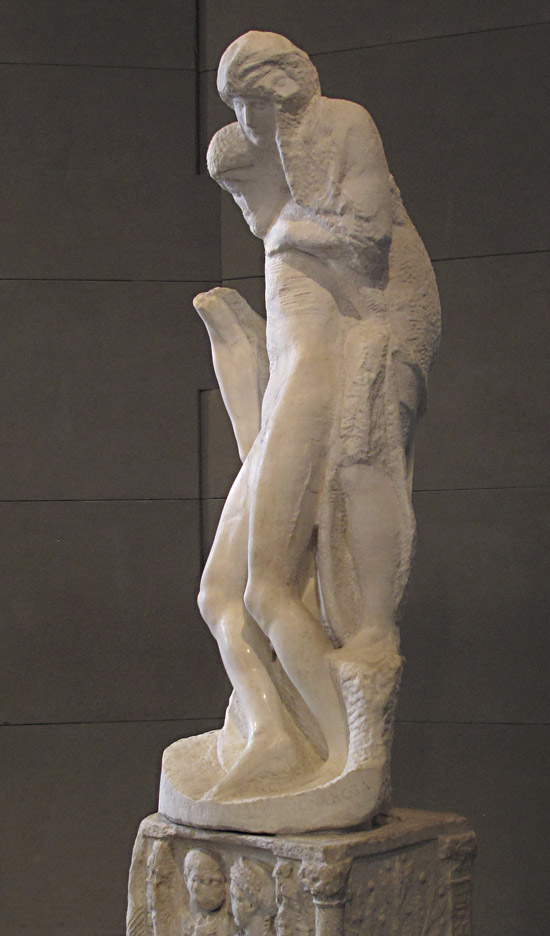

Leonardo da Vinci also left his mark in the city of Milano. He lived here for roughly 20 years and followed not only artistic pursuits, but also military and civil engineering efforts. (He designed water-flow “locks” on the Naviglio Pavese canal along which I ride my bike so frequently.) His world-renowned “Last Supper” is here in Milano at the monastery of Santa Maria della Grazie. Viewing tickets are sold months in advance, and the large salon hosting the wall mural has an atmosphere very carefully controlled to preserve what’s left of the dry fresco.
At the Castello, on the other hand, I readily walked in and bought a 3 Euro ticket to view the whole museum complex. I proceeded past stone remnants from centuries past.
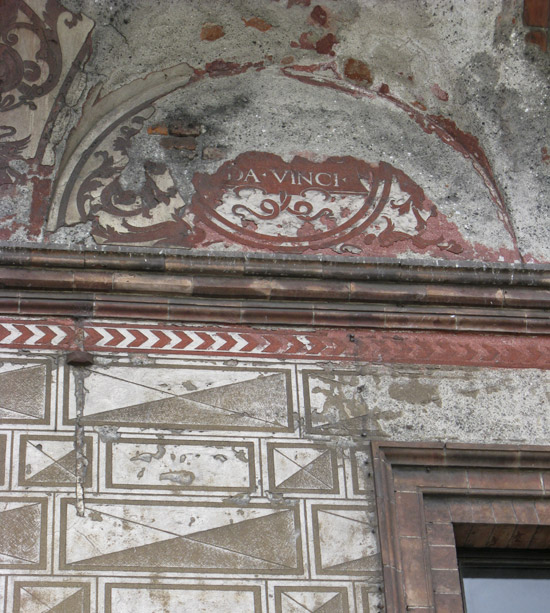
“Court of the Dukes Museum of Art”
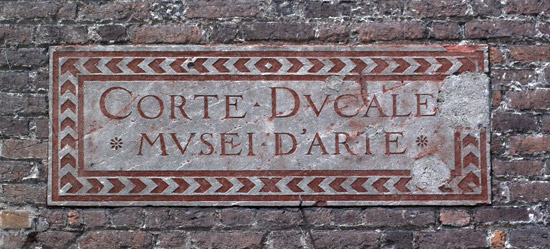
(This letter “P” is for my sister, by special request.)
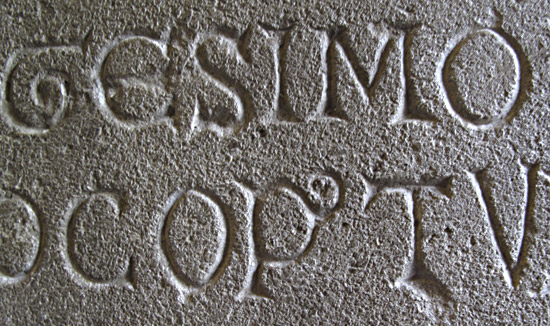
And I was amused by this type correction. (Ooops.)

I walked into grand rooms with elaborately painted ceilings and draped with tapestries, this one of St. Ambrogio, the patron saint of Milano.
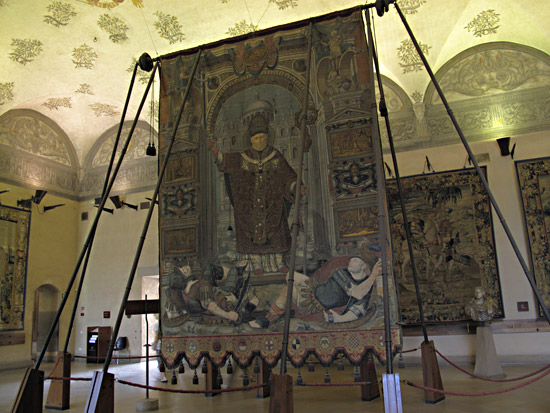
And then I walked into an entirely unexpected and very dark room. The “Sala delle Asse” was painted by Leonardo c. 1498 across the full expanse of its ceiling and down onto its walls. Quite unlike the iconic “Last Supper”, this canopy of foliage, trunks, stone and scrollwork creates a tangle of visual detail. At first glance it looks like a mess, as if the whole surface had been consumed by black mold over the years, with a few, still-vivid blue shields positioned at quarters.
The ceiling has an equally tangled history of “restorations”, including a complete whitewash covering, subsequent cleaning and color “enhancements”. The room was restored again in 1954, undoing the heavy-handed treatments it had suffered in centuries past.
It was a hard place to photograph, but you can find more images here. (Looking at some of them, I can’t believe we were looking at the same ceiling!)
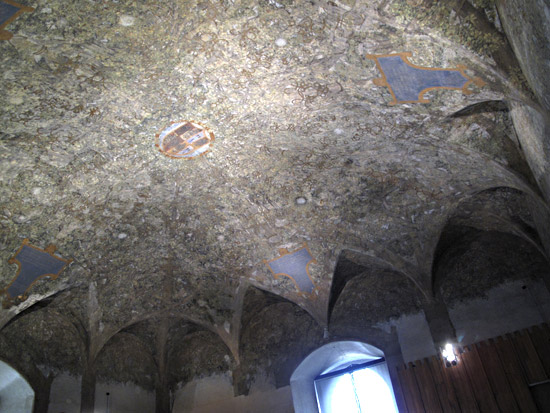
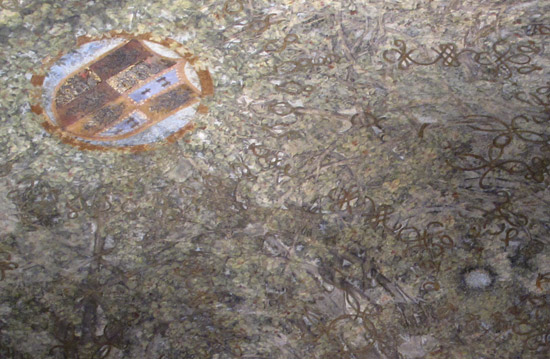
The Castello has a grand inner courtyard, with an interior moat home to dozens of cats! The museum sections are housed in the building ring around the courtyard.
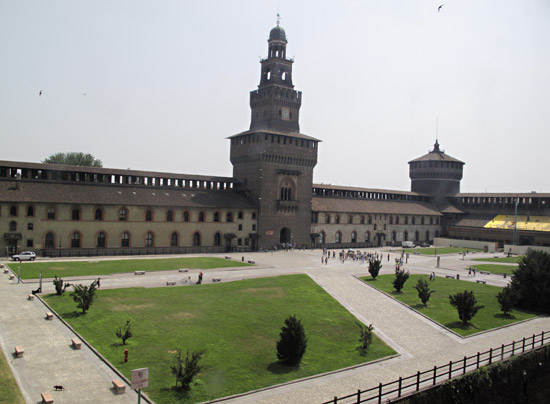
The Castello Sforzesco is a hub and a landmark for the city, stalwart and visible from a distance. One can make the short, straight walk from Castello to Duomo.
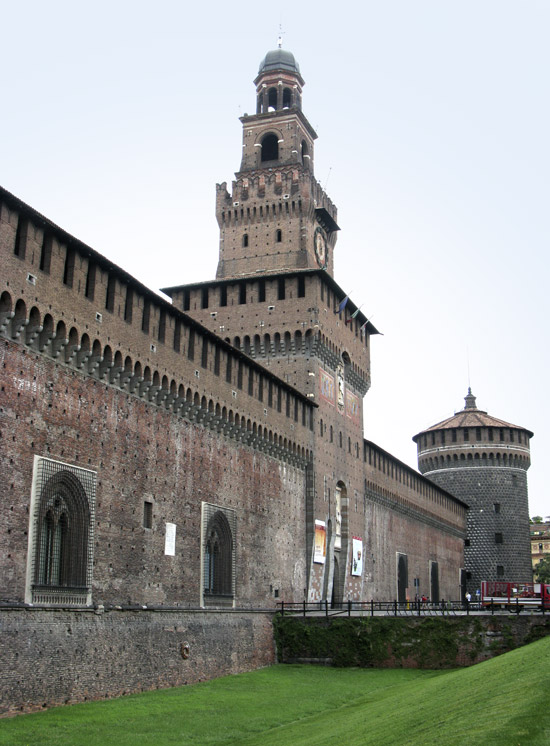
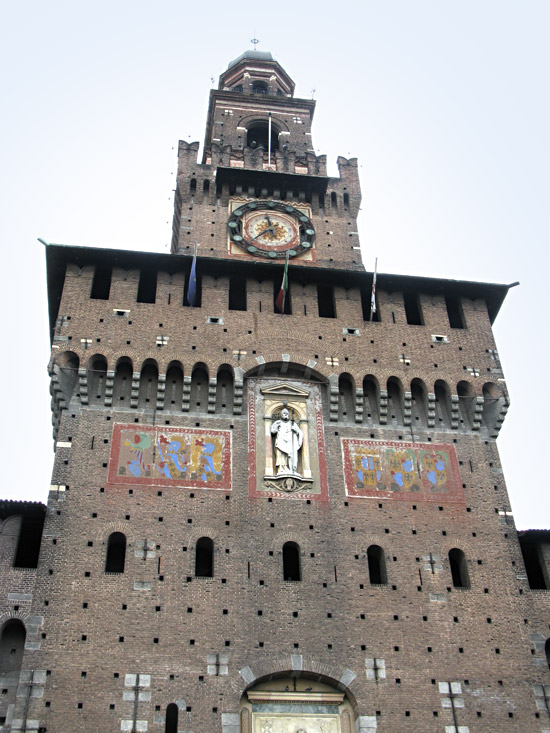

by Maureen | Jul 6, 2010 | Discoveries, Featured Articles, Food!, Incredible Locations, Journal, Meals, People, Photo of the Day, Photos, Sanremo
Last Friday, after my whirlwind morning in Genova, I continued on to Sanremo for what was likely my last visit with my “landlady” Sandra and her husband, Mauro, before my departure from Milano. I had visited them a couple of times in winter and at my departure then it felt as if longtime friends were bidding “arrivederci“.
It was hot even in Sanremo, which is usually milder than the inland. Sandra and I sat in the cool of the house, and later on the porch swing, covering every topic from food and family, to health, spirituality, friendship and life approach. (Not bad considering it was all in Italian.)
Mid-afternoon, it was time to start dinner: homemade Sardenara and Focaccia, carpaccio of Tuna (thin slices of raw tuna), and insalata di gamberi e rucola (salad of shrimp and arugula).
Sardenara is specific to Liguria, the part of Italy up north and west along the Riviera, approaching France. You can’t quite call Sardenara “pizza”, but rather a focaccia pan bread with very specific ingredients. Sandra made a dough of a specific semolina flour purchased especially for this recipe. A friend, Angelo, had shown her how to make this.
She rolled and formed the dough into the square baking pans, then set them aside to rise.
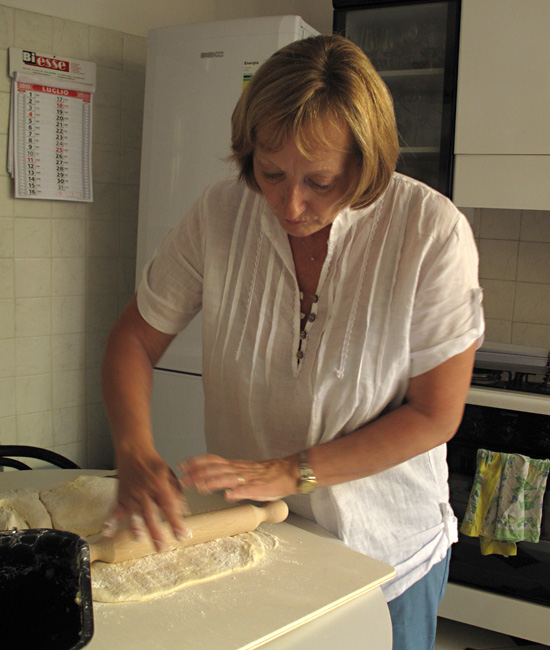
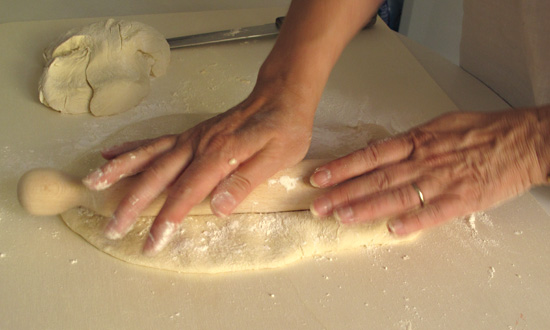
After the dough had risen, Sandra selected one pan for a simple focaccia with coarse salt and olive oil. The finger indentations in the dough, and more than a splash of water (!) poured on top before going into the oven, were two secrets important to the recipe.
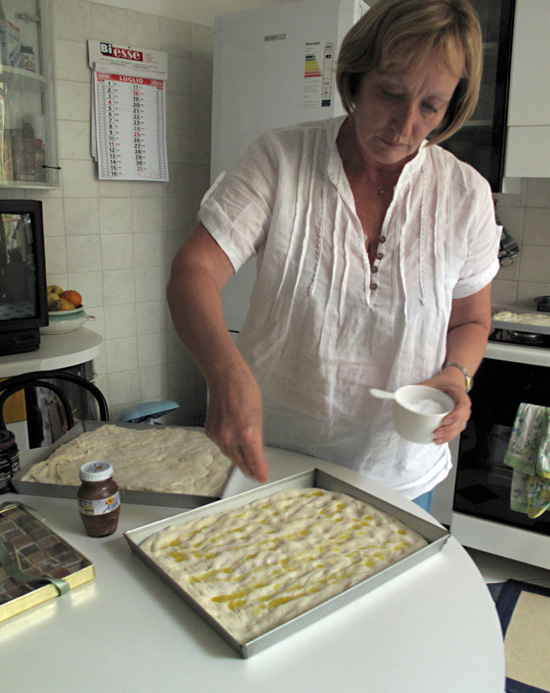
Next came the very simple, yet specific, Sardenara preparation: a base of peeled, cooked tomatoes; taggiasche olives, local to the region; salted anchovies; garlic cloves, olive oil, oregano, coarse salt, water.
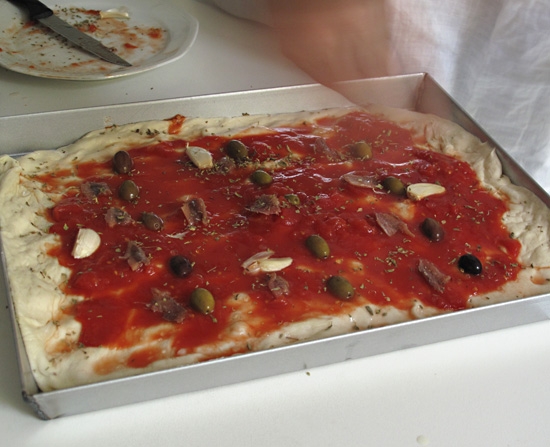
The Sardenara cooked up to a half-inch thick bread with a wisp of tomato and the pungency of olive and anchovy. It began our dinner.
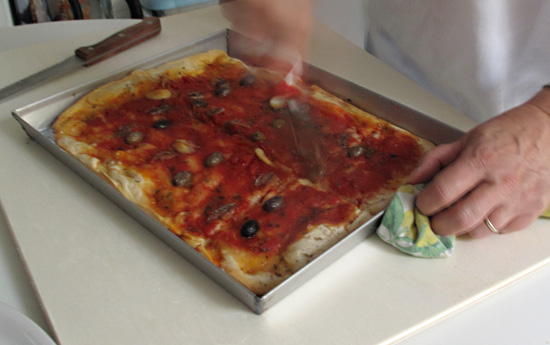
Mauro, Sandra’s husband, was hungry and ready for dinner.
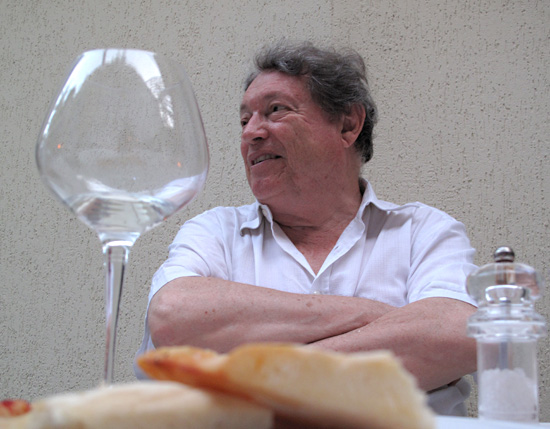
A perfect summer meal, begun with fresh Sardenara, and followed with a simple salad of arugula and shrimp, and tuna carpaccio. All light and delicious for a hot day.
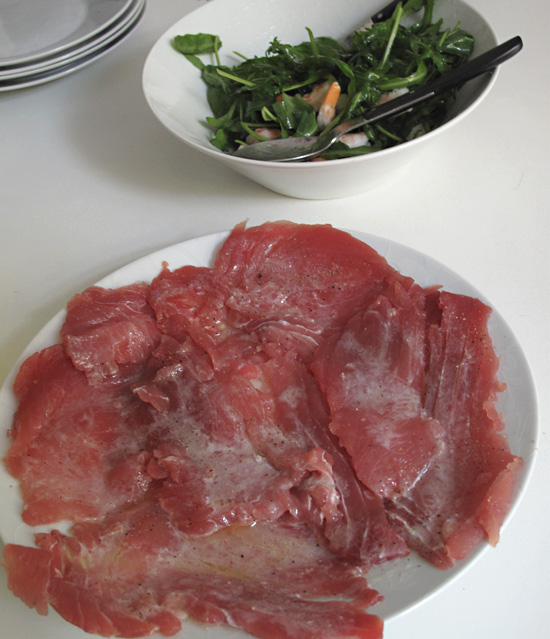
Sandra and Mauro’s friend, Sandro, joined us for the meal. We had all spent time together in the wintertime, (including our trip to Monaco and a meal of Sandro’s special pureéd rabbit liver sauce over freshly-made pasta). He dished up the tuna carpaccio, which had been doused with fresh-squeezed lemon juice and olive oil. It was fantastic!
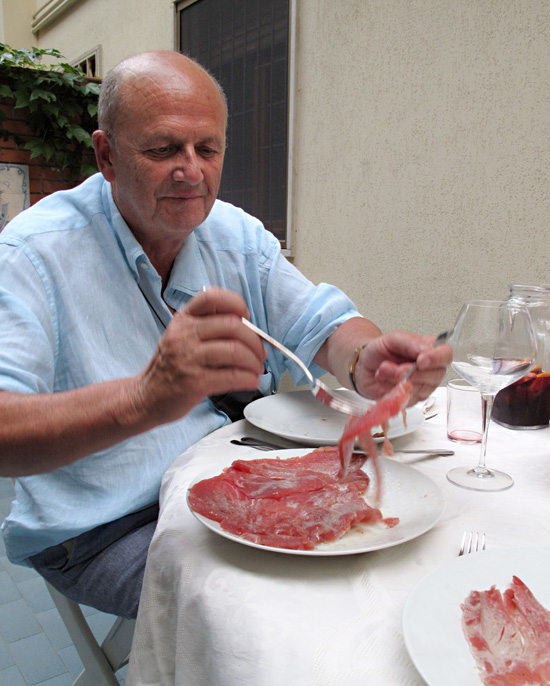
The salad was dressed simply with lemon juice, olive oil, salt and pepper.
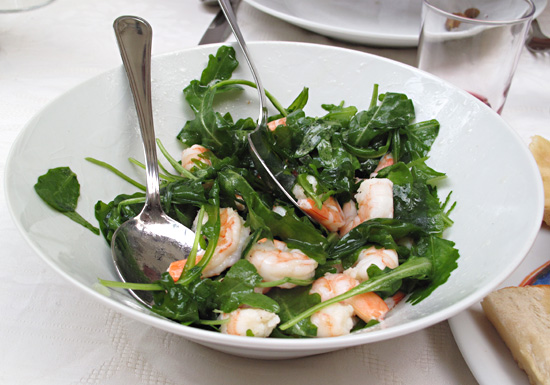
Dinner was a lovely time with my new “old friends”. And the making of it was as much a part of the pleasure, as was the conversation throughout it all.
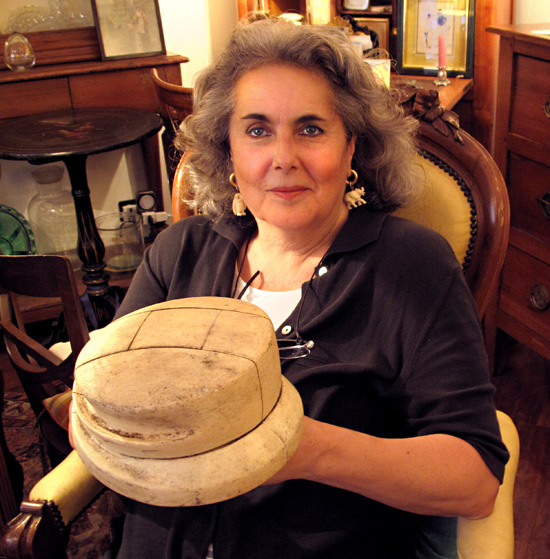
by Maureen | Jul 6, 2010 | Featured Articles, Genova, Incredible Locations, Journal, People, Photo of the Day, Photos
It all started with hat forms on Milan’s Grand Canal.

Five weeks ago I went to the Mercatone Antiquariato – Antique Market – along the Naviglio Grande and saw hat bases made of coarse fabric. They are from the Bovone sisters that were making hats in the 1930s. The hats have asymetrical, sumptuous curves and show the “hand” of their makers through stitches and markings.

The hat bases harkened to the beautifully-sculpted wooden hat forms I did NOT buy in Florence in March but still thought about. I bought 3, chatted a bit with the woman selling them and asked for her business card.
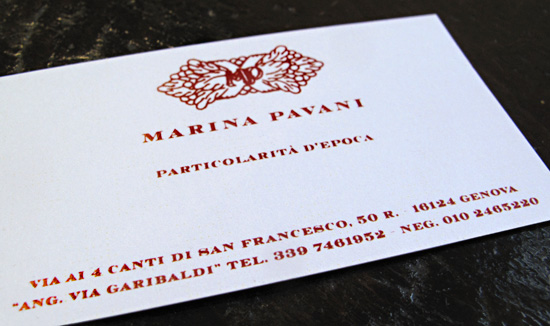
A week ago, back at the antique market, the woman was there again and she had wooden forms this time! I considered them all and picked one to bring home. The seller, Marina Pavina, and I introduced ourselves and talked some more. She was insistent: “you should come to Genova!” I had already planned to go through Genova, her home town, on my way to San Remo a week later, so we agreed to meet there.
At the end of the train ride from Milano, I stepped out of the station into a 90-degree day and was met by Marina and her husband, Claudio. They took me on a city overview driving tour of Genova, port city and home of Cristoforo Colombo. There was much that reminded me of Seattle: the waterside location, the surrounding ring of hills, the elevated viaduct, the busy international port. Yet it is all tighter and closer in.
Claudio stopped long enough for Marina and me to get out and see the front of Cristorforo’s house, as well as the adjacent towered city entry.
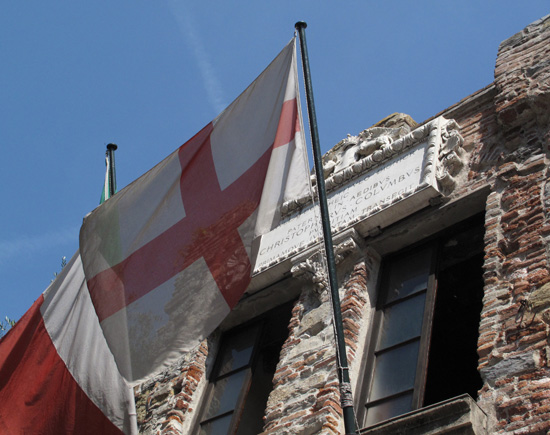
Two towers create an arched entry gate into Genova’s Molo neighborhood.
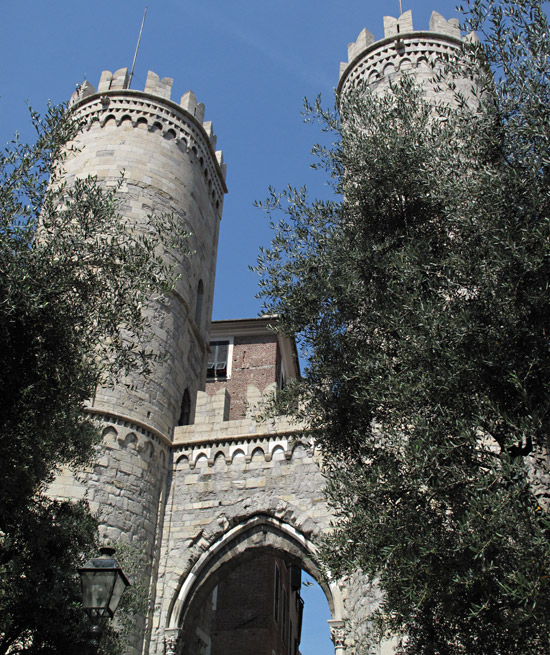
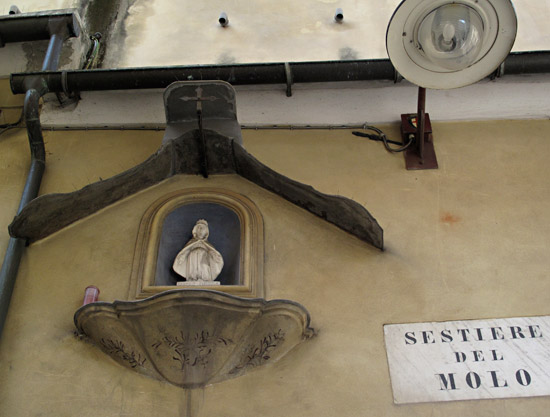
This madonna and two plaques are mounted underneath the arch. The top plaque is from 1865. (I’ve recently brushed up on reading roman numerals. It comes in handy here in Italy.) Madonnas and other religious niches like this are found all over Italy, reflecting the high number of Catholics in the country.
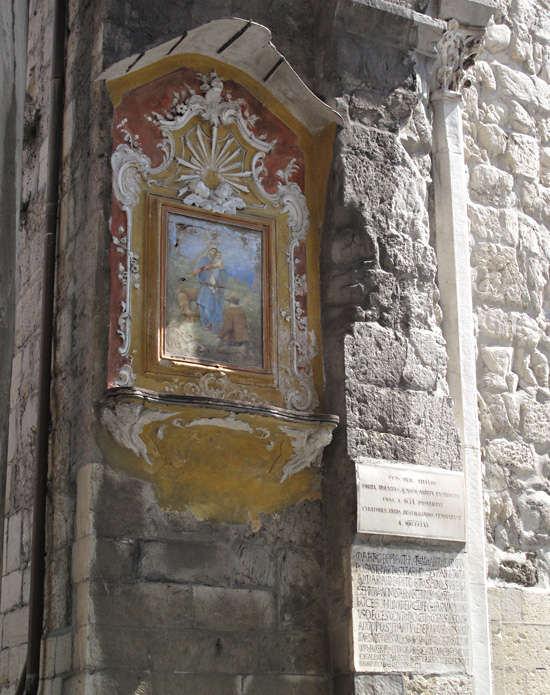
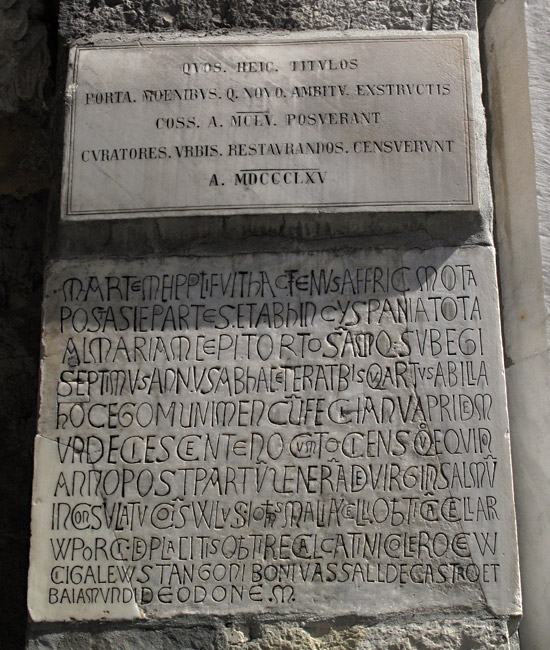
I’ve never seen such a concentration of scooters than in Genova, although I was told later that San Remo has more scooters per capita. In some places in the city, there are so many scooters parked along both sides of the street that there is just enough space for one car to pass between them, lane lines having no meaning.
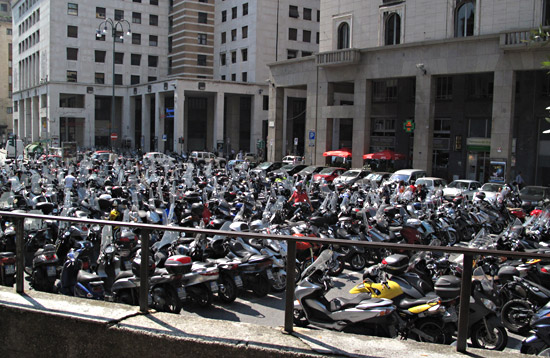
After our driving tour, we parked the car and took a stroll along the beautiful and historic Via Garibaldi. Genova has elaborately frescoed and decorated buildings like I’ve never seen (nor will) in Seattle. Just envision this building without its fresco painting!
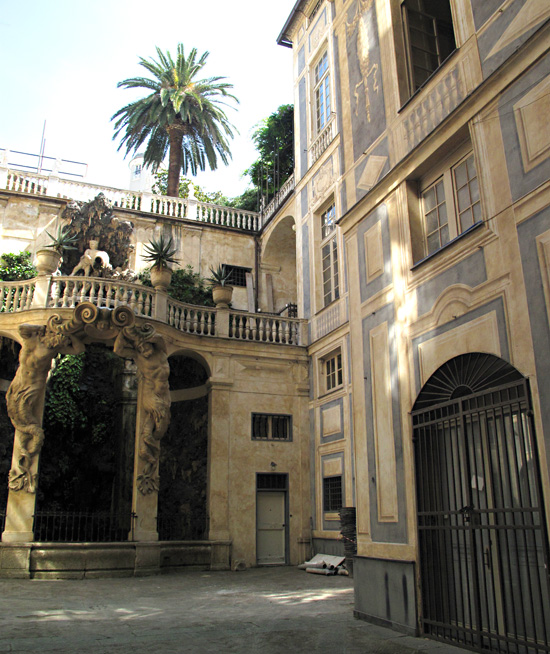
This is an interior foyer just off the street.
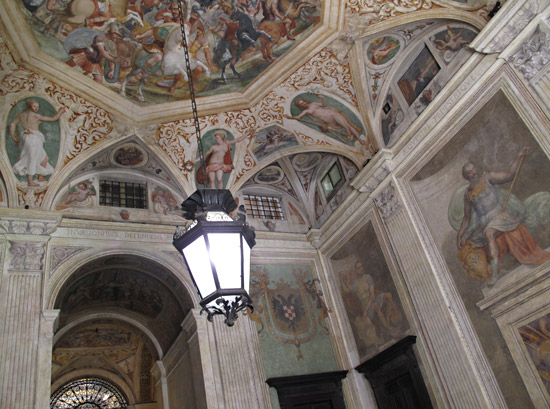
This ceiling reminds me of Wedgwood pottery.
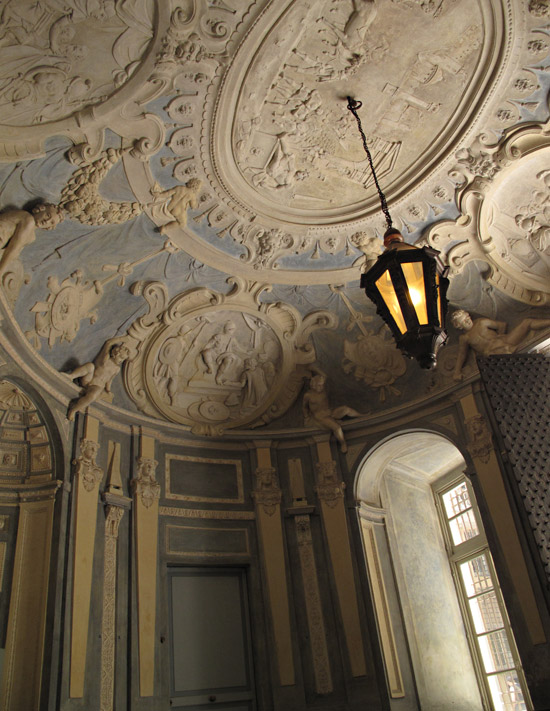
Our next stop was Marina’s antique shop, “Marina Pavani Particolaritá D’Epoca”, just off Via Garibaldi near the museums.
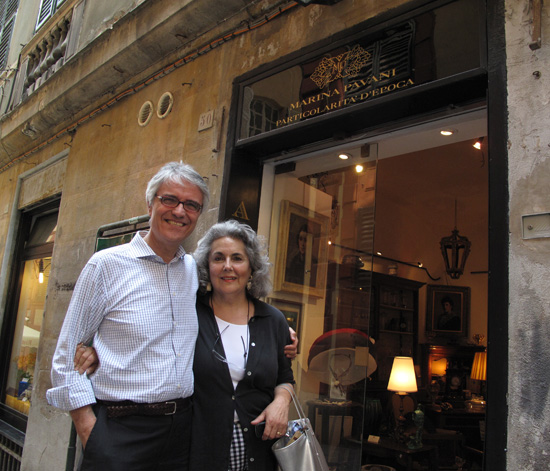
Marina offers art pieces, furnishings and decorative objets d’art covering a broad time period. Whether a person is looking for a large, prominent piece, or a small, visual detail, Marina’s collection piques the curiosity. She also does custom searches and display work.
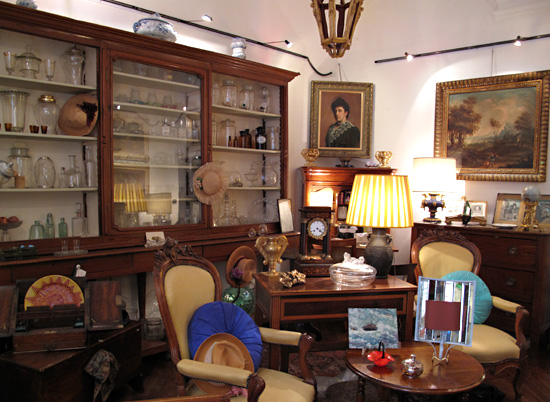
.
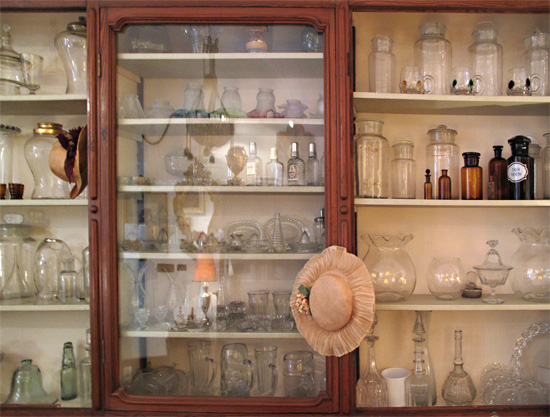
.
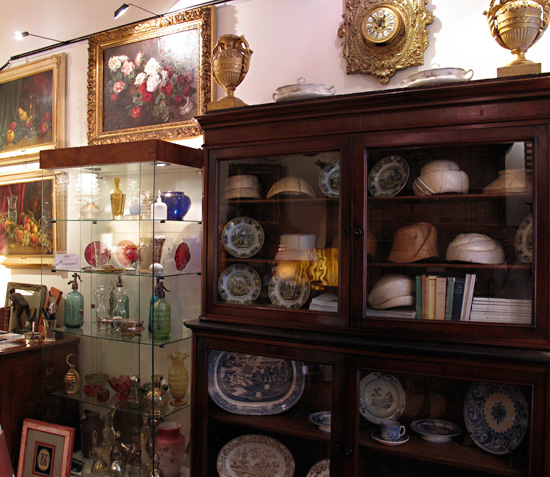
Here’s a sampling of some of the hat forms that caught my eye in the first place.
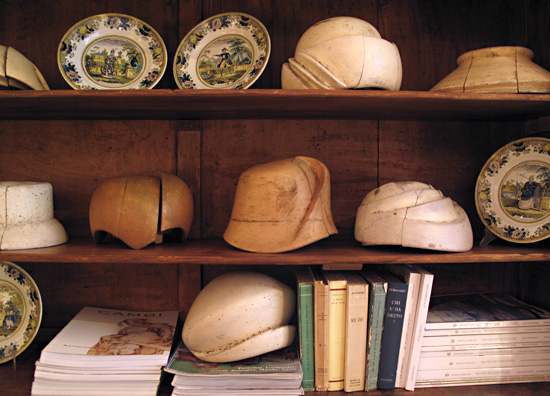
The hat forms are constructed of 5 wooden pieces joined with large dovetail joints, then sculpted and painted. Damp hat fabric, likely felt, is draped over the form, pressed and pinned into the depressions and left to dry. When removed, the fabric will have taken the shape of the hat form.
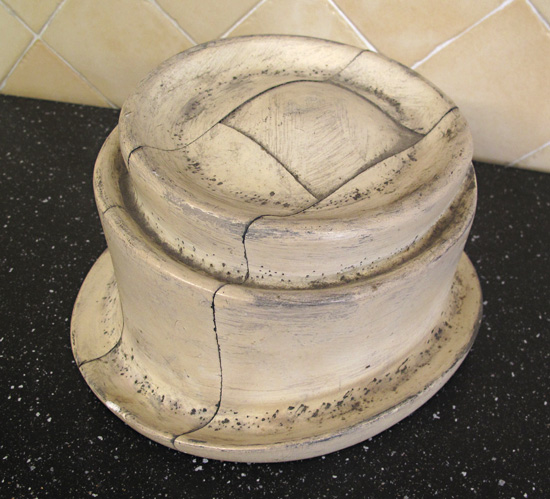
I bought this second one while in Marina’s shop in Genova. I like all the patina and pin holes as much as the lovely curves of the forms themselves.
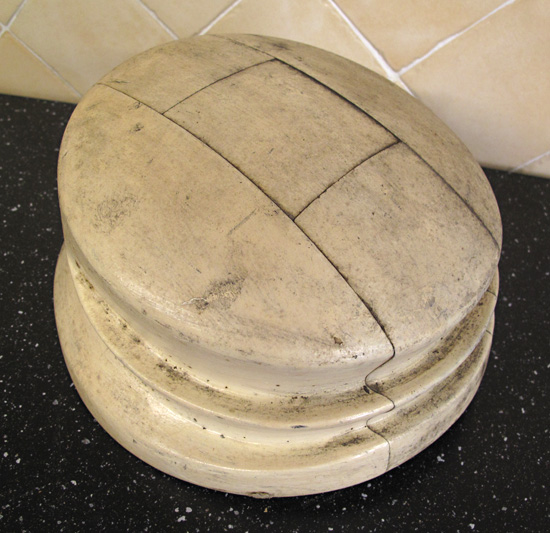
While looking at the underside, the dovetail joints and form numbers are visible.
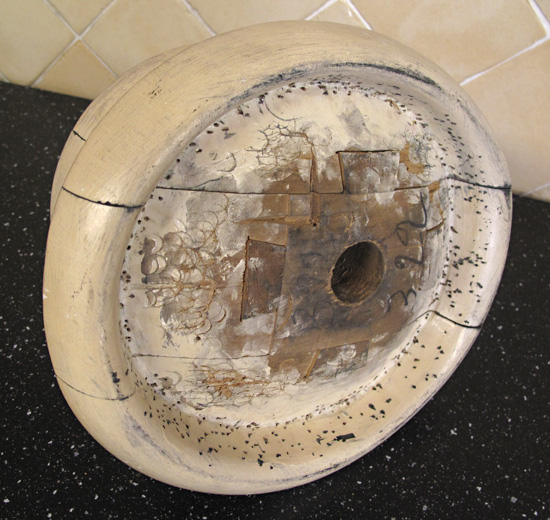
After browsing the antique shop, Marina and Claudio treated me to lunch at a cafe nearby.
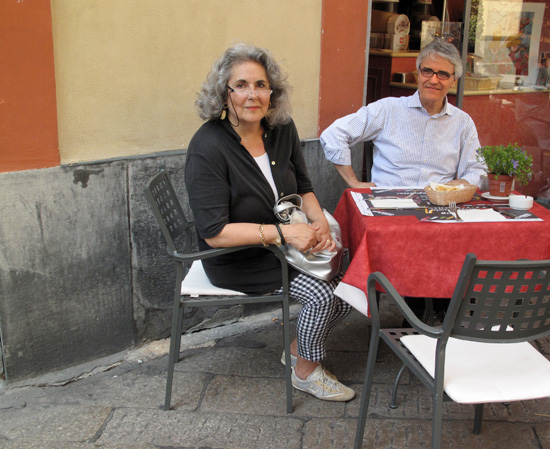
.
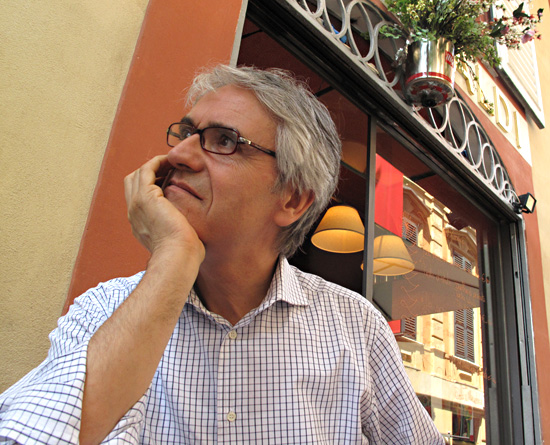
We rushed through our lunch and finished just in time for them to drop me off at the station and give each other quick goodbyes. I then waited on the platform for a half-hour-late train on a sweating-hot day.
What’s most remarkable to me, again, is the kindness of strangers that I have been encountering. I don’t know Marina and Claudio, and yet they hosted me warmly in their home town, and we chatted like long-time friends.
If you find yourself in Genova, step into Marina’s shop. See what catches your eye and enjoy a pleasant conversation.
Marina Pavani Particolaritá D’Epoca
Via Ai 4 Canti di San Francesco, 50 R. 16124 Genova, Italia
(Angolo Via Garibaldi)
Tel: 339-7461952
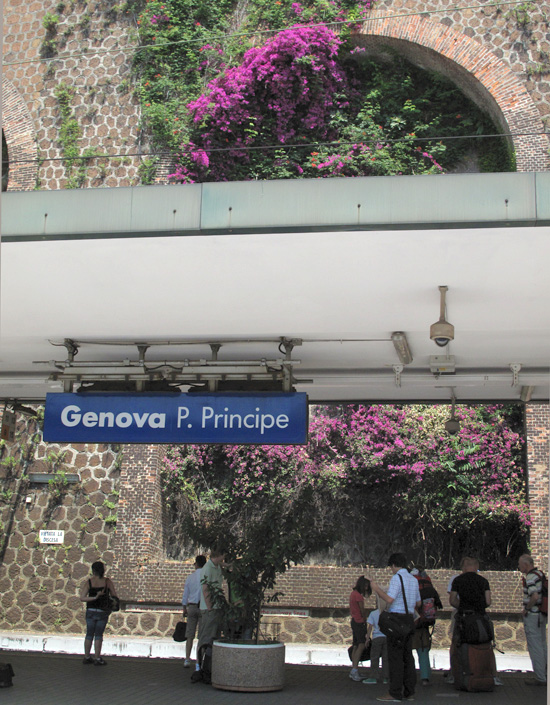
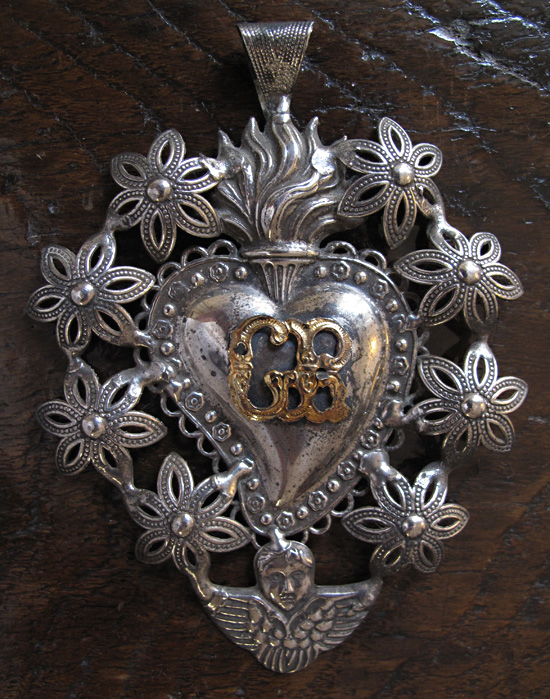
by Maureen | Jul 1, 2010 | Church, Featured Articles, Graphics, Incredible Locations, Journal, Photo of the Day, Photos
Two years ago, in exploring one church after another, I noticed cathedral walls laden with silver framed medallions bearing the letters “GR”. Some were tied with a pink or a blue ribbon. There may have been 50 in some churches, or hundreds in others.
Here’s a wall in the Duomo of Sienna (from 2008).
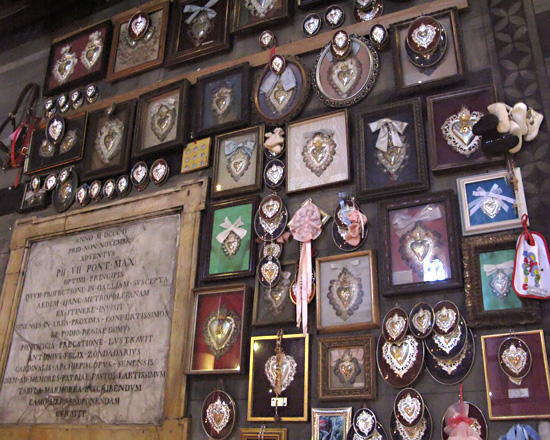
With an interest in symbols and icons, silverwork and folk art, I was intrigued. What were these? What meaning did they hold to those that posted them?
In Firenze, I went into a store selling Catholic statues, vestments, rosaries and other religious items and talked to one of the nuns working there. She explained “Per Grazia Ricevuta” – “For Grace Received” – this physical symbol of gratitude. The medallions are placed in the cathedrals at the birth of a child, the healing of an illness or injury, or other instances of great grace. (I bought one for my brother to acknowledge him, his wife and 5 kids.)
Two years later, now back in Italy, I continue to see the Grazia Ricevuta medallion. It moves me that the Italians have this tangible symbol for their gratitude . (I rack my brain trying to think of an American corollary.)
– – –
I feel such deep gratitude for the opportunity to be here. I have the means and the fortitude to have come for a year even in the midst of global economic crisis. I have experienced no mishap, illness or calamity. I have remained safe both when traveling alone and riding my bike amidst crazy, Milanese traffic. My family, friends and clients back home have been supportive and steady. New friendships and chance meetings here have kept me from loneliness and given me the highlights of my time. I have seen things that have filled my head with images to last my lifetime. THIS has been a great grace received and I am genuinely humbled by the gift.
– – –
The Grazia Ricevuta has become increasingly touching to me as my time passes here in Milano. I purchased another framed medallion to hang in my home when I return. And I just purchased one (below) from the antique market which I will wear on occasion. When you see it, you will know its meaning to me.

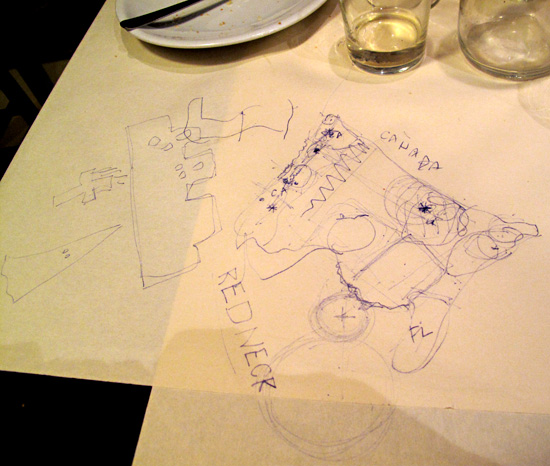
by Maureen | Jul 1, 2010 | Featured Articles, Introspection, Journal, Quips
More often than not, when I’m talking to Italians and they tell me they want to travel to the U.S., they all say the same thing: they want to go to New York, Miami… and Niagara Falls. (Huh? Niagara Falls?) They tell me that TV and movies have influenced them; they’ve seen more mention of New York and Miami than any other place.
Yesterday, out for a late night dinner with an Italian friend, at a restaurant with paper tablecloths, I started sketching a map of the U.S. and talking about the regional differences across the country. In trying to communicate the tremendous variation in geography and culture we covered a LOT of topics! (Of course, all from my own point of view…)
Here’s a list of some of the things we talked about. How many can you find noted in the sketch below?
- Seattle, Portland, San Francisco, Los Angeles, Chicago, New York
- Grand Canyon, Cascade Mountains, Rocky Mountains, Great Lakes, Gulf Coast Marshes
- Pacific Northwest, West Coast, Southwest, South, Midwest, New England,
East Coast, Florida, border with Canada
- BP Oil spill and threatening Hurricane Alex
- Conservative, liberal, up-tight, traditional, racist
- Rednecks, Ku Klux Klan, cross-burning
- Cities, population centers, farm country, apples, pears, grapes
- The Adobe homes of the Southwest
- Where I went to school in California and Ohio
- My long, one day drive from San Jose to Seattle
- The “boot” of Italy and the cultural divide between north and south
The cultural divide between northern and southern California

by Maureen | Jun 30, 2010 | Discoveries, Journal, Quips
“Allora…”
I hear it all the time, and I did 2 years ago when I was here… so much so that I asked about it. It’s the Italian “umm”, the bridge between thoughts. The pause. The word that says, “give me a minute”. It’s the drawn out “wellllll…”
Every language has these words so laden with function, if not meaning. It’s just funny to hear them so clearly.
(I suppose that if you don’t speak any Italian this post means nothing to you. But if you do, you might be chuckling to yourself in acknowledgement right about now.)










































































